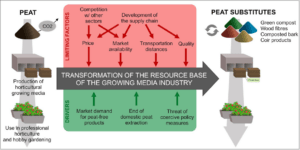A new peer-reviewed publication on peat replacement in Horticulture has been published by the Johann Heinrich von Thünen Institut.
 Peat is the major constituent of horticultural growing media. Due to its high climate footprint, its extraction and use are controversial and the need to limit its use is widely recognised. The Peat Use Reduction Strategy of the German government aims to phase out its use and replace it with renewable materials. Despite the large potential, stakeholders consider the availability of peat substitutes in sufficient quantity and quality as a critical issue. The goal of this research is to systematically investigate the challenges and opportunities for substituting peat in the resource base of the growing media industry.
Peat is the major constituent of horticultural growing media. Due to its high climate footprint, its extraction and use are controversial and the need to limit its use is widely recognised. The Peat Use Reduction Strategy of the German government aims to phase out its use and replace it with renewable materials. Despite the large potential, stakeholders consider the availability of peat substitutes in sufficient quantity and quality as a critical issue. The goal of this research is to systematically investigate the challenges and opportunities for substituting peat in the resource base of the growing media industry.
Based on deep-dive interviews with German growing media producers, the factors determining the supply and use of the main growing media constituents—peat, green compost, wood fibers, composted bark and coir products—were analysed. The results show the critical role of the processing infrastructure on transportation distances and the quality and quantity of the market supply. Additionally, competition with other sectors affects the availability of materials for the growing media industry. Moreover, peat is still economically advantageous compared with its substitutes. Even if this advantage declines due to consumer awareness and the end of domestic extraction, the end of peat use would probably imply new policy measures.
The new peer-reviewed publication is published in Horticulturae 2023, 9(8), 919 and can be accessed here.
Published on Twitter here.
Source: Thünen-Institut: https://www.thuenen.de/de/
